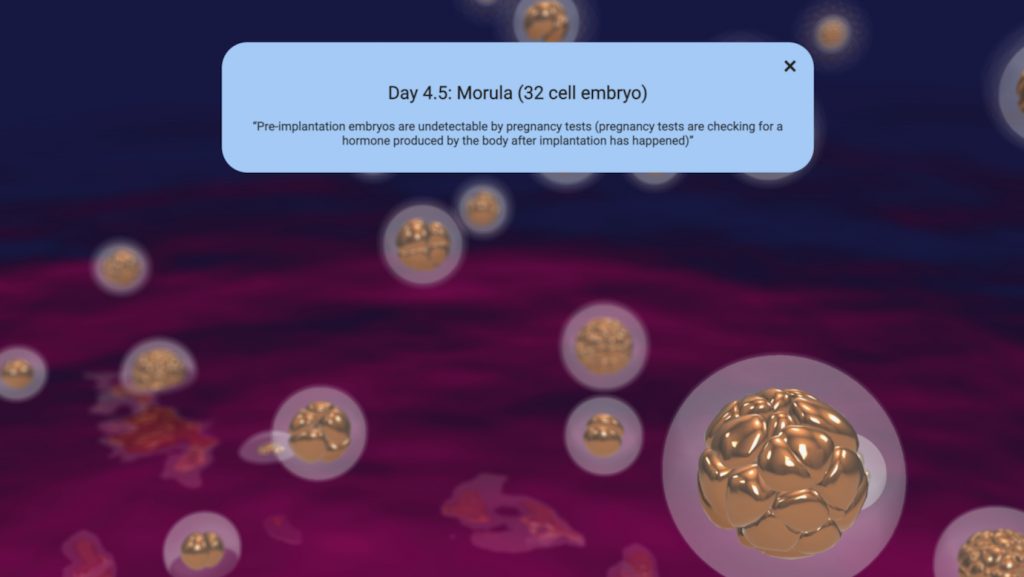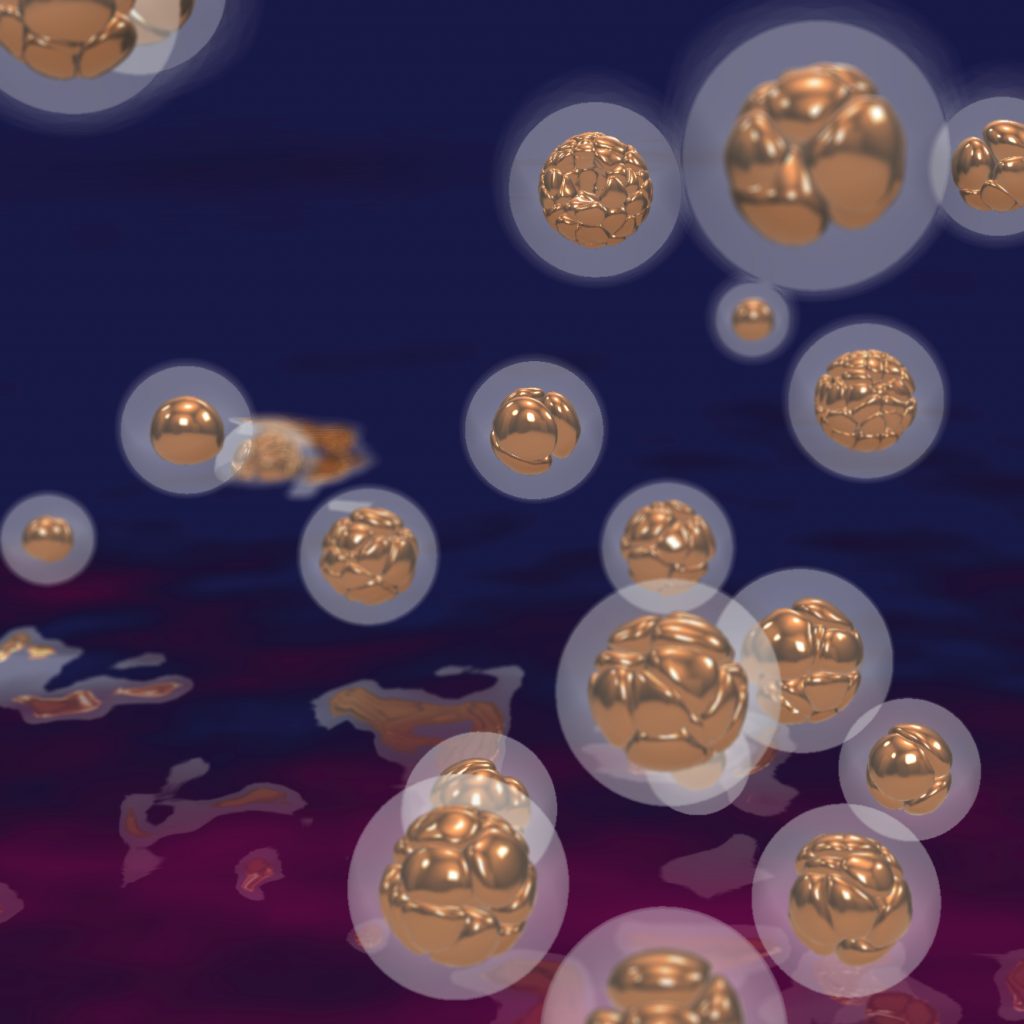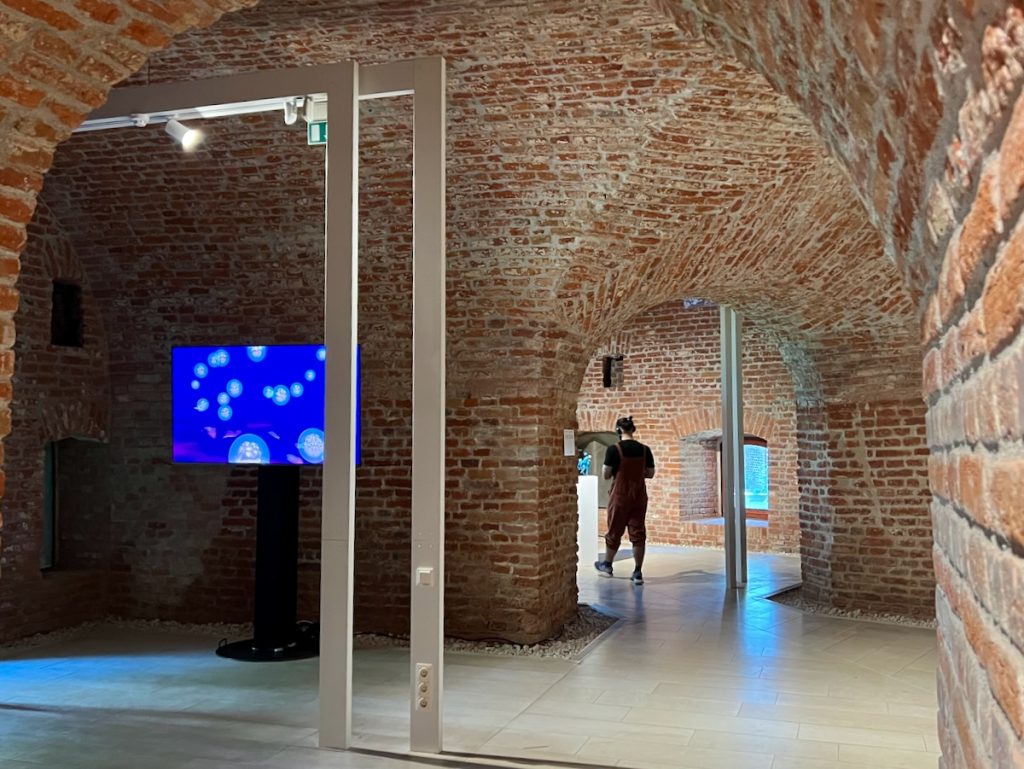
Explore “Precious Cells” (2023) via your own web browser (on your phone, tablet or computer) to discover scientific, societal and ethical points of view on human developmental biology research. Click on the button below to access the artwork, and then click on the embryos to find out more about this research.
This new interactive online (browser-based) artwork by Anna Dumitriu delves into the fascinating story of donated human embryos used in scientific research to understand how we develop: from a fertilised egg to a functioning human being. A better understanding of early human development may one day lead to better treatments for many conditions such as infertility, childhood cancers, spina bifida, heart defects and many other conditions.
This artwork was informed by a series of conversations between members of the public, scientists who work with early human embryos and the artist. Embryos that are produced for fertility treatment but will not be used for family building are a hugely valuable resource for scientists who rely on the generosity of patients to donate them for research. Click here for more information about the different types of tissues researchers work with to understand better how humans develop before birth.
In the artwork, the golden colour of the tiny clusters of cells represents their preciousness for research. The liquid environment in which they are depicted represents the environment in which human embryos develop in the lab. The 3D digital models of embryos are based on microscope images from laboratory research.

The artwork was supported by the Human Developmental Biology Initiative (HDBI) and the Gurdon Institute, University of Cambridge. Funded by Wellcome. Coding and 3d modelling by Alex May.
Members of the HDBI public panel (the ‘Insights Group’), scientists and a policy expert from Progress Educational Trust provided valuable input in conversations about research with early human embryos.
The project was inspired by the work of Dr Marieke Bigg and her research on Dame Anne McLaren, a Pioneering Scientist in Developmental Biology. Dame Anne McLaren (1927-2007) was one of the most eminent and highly respected reproductive biologists of the twentieth century. Her most enduring interest as a scientist was in sperm, eggs and early mammalian development. Her work helped to recognise the importance of stem cells in treating human disease, and her research in the basic science underlying infertility treatment helped develop several human-assisted reproduction techniques, including embryo transfer, preimplantation genetic diagnosis and somatic cell nuclear transfer (“therapeutic cloning”).

A gallery installation version has also been created which is intended to be shown alongside a selection of the quotes used in the interactive browser based work.

References
- “The human egg is 0.1 mm in diameter, about the thickness of a piece of paper. The human blastocyst (this is what we call an egg that was fertilised about 5-6 days ago) has a diameter of about 0.1–0.2 mm and is a hollow ball of about 200–300 cells.” https://www.ncbi.nlm.nih.gov/books/NBK26842/
- “Pre-implantation embryos are undetectable by pregnancy tests (pregnancy tests are checking for a hormone produced by the body after implantation has happened)” https://my.clevelandclinic.org/health/body/22889-blastocyst
- McLaren, Anne. 1981. Germ Cells and Soma: A New Look at an Old Problem. New Haven and London: Yale University Press.
- McLaren, Anne. 1984. Where to Draw the Line? Journal of the Royal Institution, 56, pp.101–121.
- McLaren, Anne. 2007. ‘A Scientist’s View of the Ethics of Human Embryonic Stem Cell Research.’ Cell Stem Cell 1 (July): 23–26.
- Anne McLaren to D. C. Evered, CIBA Foundation, 13 September, 1984, Add MS 83887, Anne McLaren (1927–2007) Papers, British Library Western Manuscripts.
- Franklin, Sarah, and Martin H. Johnson. 2008. Interview with Mary Warnock. Mammalian Developmental Biology Interviews. British Library.
- McLaren, Anne. 1989. ‘Geneva WHO Keynote.’ Lecture. Geneva. Add MS 83980, Anne McLaren (1927–2007) Papers, British Library Western Manuscripts, British Library Western Manuscripts.
- McLaren, Anne. Thanks-MSU, British Library, Add MS 89202/2/13, undated.
- Progress Educational Trust
Exhibitions

BioArt Revolution/ Revoluția BioArt, an innovative solo exhibition by Anna Dumitriu which brought together contemporary artistic approaches and modern scientific experiments to address issues of global relevance such as infection, climate change, and diversity. The show was part of Timișoara 2023 European Capital of Culture, from 30th September to 1st October 2023. The exhibition, which was created in collaboration with the Romanian Science Festival, took place in the stunning setting of Bastionul Maria Theresia, Galeria 2, Str. Hector, nr. 1, Timișoara, Romania.
“BioArt Knowledge” at the Yarrow Gallery at Oundle School in Oundle, UK from 9th November to 6th December 2023 and as a full scale building projection on the historic facade of the gallery on 9th November 2023.
Precious Cells, the Cambridge Festival (University of Cambridge) 2024, an exhibition that delves into biological research’s artistic, sociological and linguistic aspects with human tissues, including early human embryos. 10:00am-6:00pm daily from Wednesday 13th March until Wednesday 20th March 2024, Grand Arcade Centre, Cambridge, UK.
Funded by Wellcome




